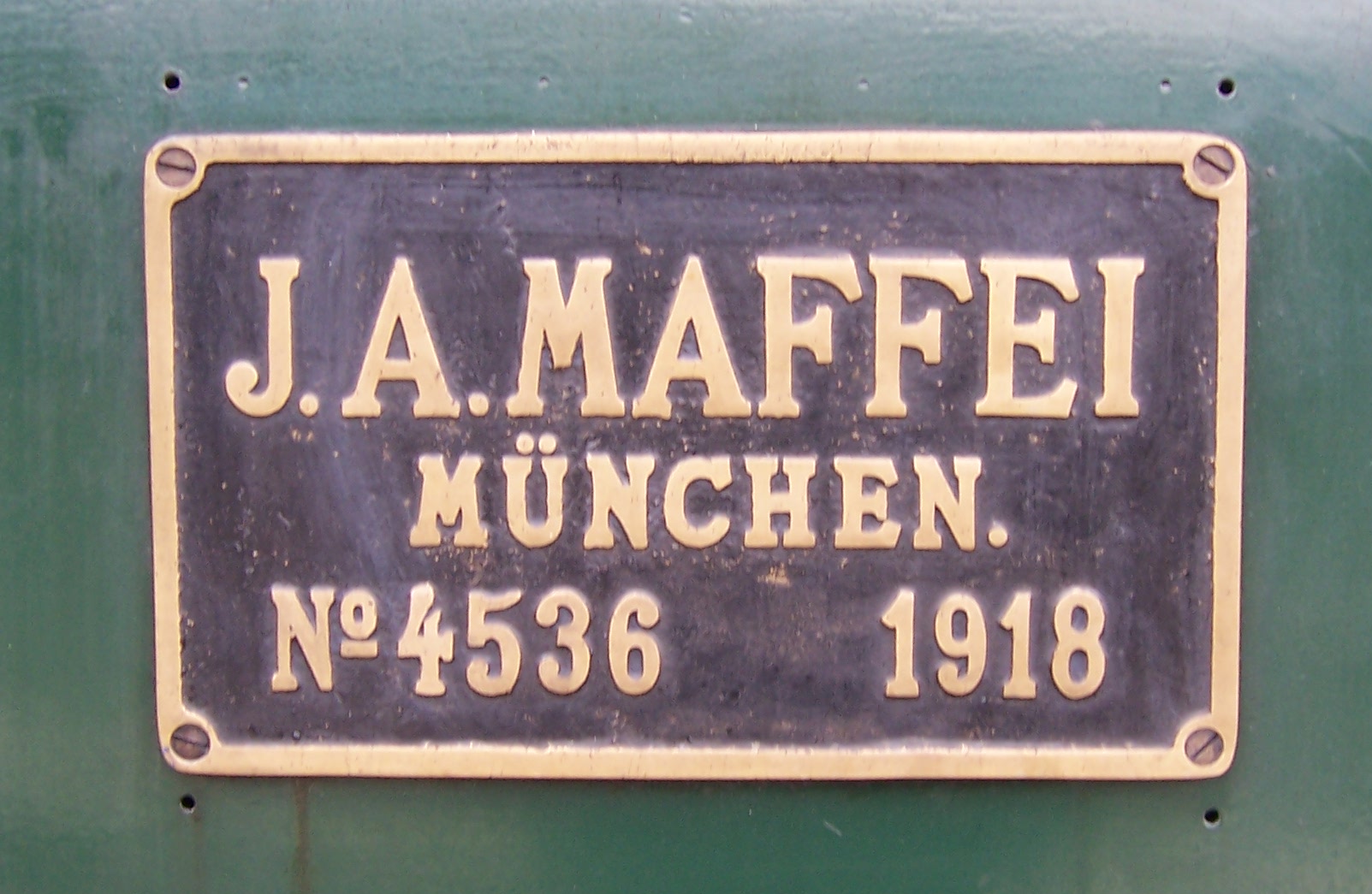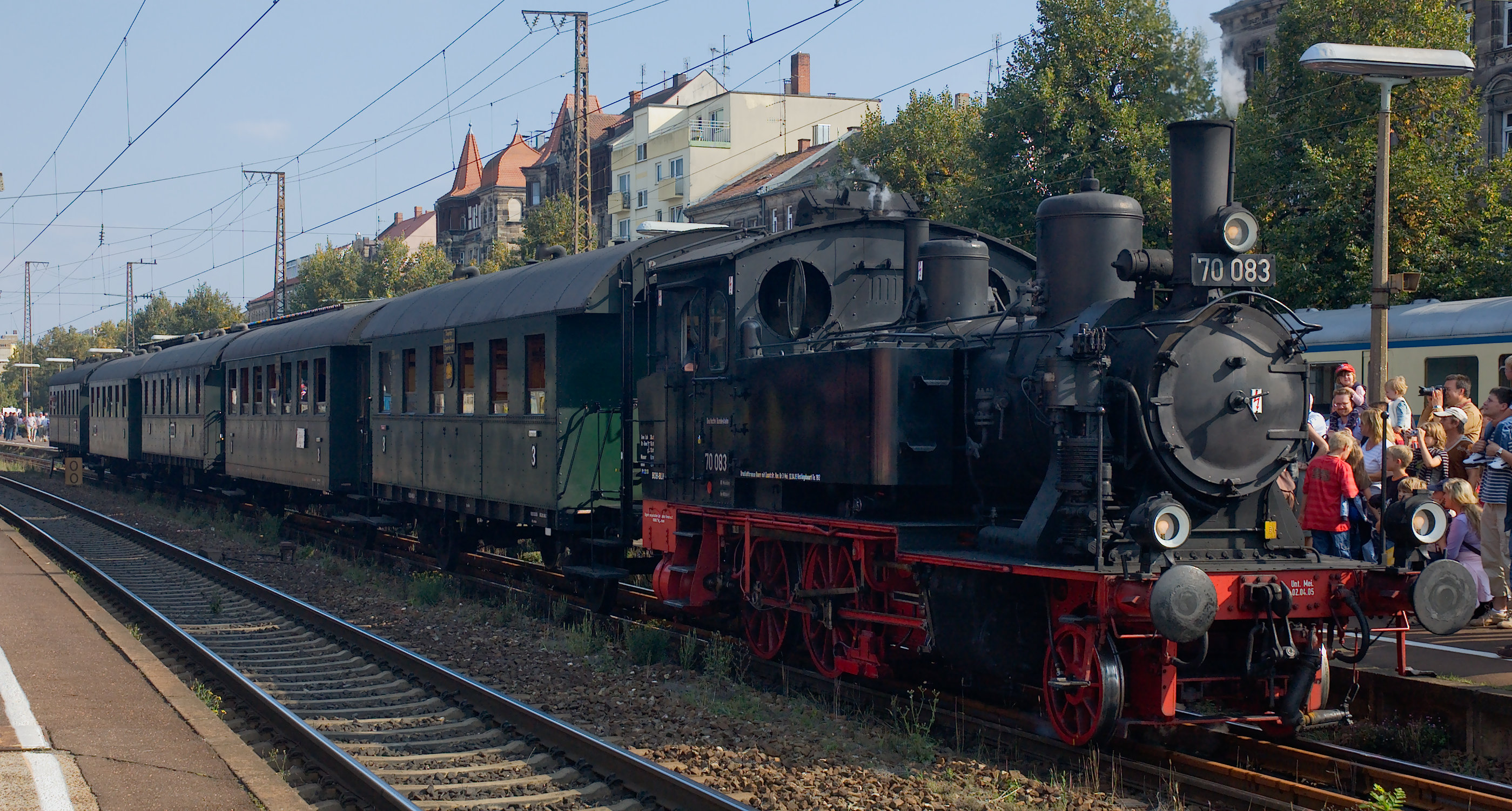|
Bavarian D VII
The locomotives of the Bavarian Class D VII were saturated steam locomotives of the Royal Bavarian State Railways (''Königlich Bayerische Staatsbahn''). The D VII was built, in parallel with the D VI, as a six-coupled locomotive for hilly routes. A total of 75 examples were made, 41 by Krauss and 34 by Maffei. From 1885 the locomotives were somewhat longer, and had more water and coal capacity, so were also heavier. The Deutsche Reichsbahn-Gesellschaft took over all 75 locomotives in 1925 as DRG Class 98.76 (''Baureihe 98.76''). Most were retired by the end of the 1920s, the last one however not until 1935. One example, D VII no. 1854 – later 98 7658, is in the branch line museum at Bayerisch Eisenstein owned by the Bavarian Localbahn Society. See also * Royal Bavarian State Railways The Royal Bavarian State Railways (''Königliche Bayerische Staats-Eisenbahnen'' or ''K.Bay.Sts.B.'') was the state railway company for the Kingdom of Bavaria. It was founded in 1844. ... [...More Info...] [...Related Items...] OR: [Wikipedia] [Google] [Baidu] |
Georg Krauss
{{disambiguation ...
Georg may refer to: * ''Georg'' (film), 1997 *Georg (musical), Estonian musical * Georg (given name) * Georg (surname) * , a Kriegsmarine coastal tanker See also * George (other) George may refer to: People * George (given name) * George (surname) * George (singer), American-Canadian singer George Nozuka, known by the mononym George * George Washington, First President of the United States * George W. Bush, 43rd Preside ... [...More Info...] [...Related Items...] OR: [Wikipedia] [Google] [Baidu] |
Maffei (company)
Maffei was a manufacturer of railway locomotives based in Munich, Germany. Established in 1836, it prospered for nearly a century before going bankrupt in 1930 and becoming amalgamated with the firm of Krauss to form Krauss-Maffei. Following another seventy years of prosperity Krauss-Maffei merged with Demag and Mannesmann in 1999, the resulting conglomerate in turn being sold to Siemens AG. Perhaps J. A. Maffei's most famous product was the S3/6 4-6-2 locomotive of 1908. In 1836, Joseph Anton, Ritter von Maffei established the "J. A. Maffei" locomotive works in the English Garden district of Munich. The aim was to make Bavaria competitive in the machine industry. From these small beginnings a world-renowned locomotive works eventually developed. In 1864 they delivered their 500th locomotive. Maffei, as a Munich town councillor, was praised for the building of the Hotel Bayerischer Hof. Well-known products of the locomotive works are the Bavarian S 2/6 express locomotive ... [...More Info...] [...Related Items...] OR: [Wikipedia] [Google] [Baidu] |
Steam Locomotives
A steam locomotive is a locomotive that provides the force to move itself and other vehicles by means of the expansion of steam. It is fuelled by burning combustible material (usually coal, oil or, rarely, wood) to heat water in the locomotive's boiler to the point where it becomes gaseous and its volume increases 1,700 times. Functionally, it is a steam engine on wheels. In most locomotives, the steam is admitted alternately to each end of its cylinders, in which pistons are mechanically connected to the locomotive's main wheels. Fuel and water supplies are usually carried with the locomotive, either on the locomotive itself or in a tender coupled to it. Variations in this general design include electrically-powered boilers, turbines in place of pistons, and using steam generated externally. Steam locomotives were first developed in the United Kingdom during the early 19th century and used for railway transport until the middle of the 20th century. Richard Trevithick bui ... [...More Info...] [...Related Items...] OR: [Wikipedia] [Google] [Baidu] |
Royal Bavarian State Railways
The Royal Bavarian State Railways (''Königliche Bayerische Staats-Eisenbahnen'' or ''K.Bay.Sts.B.'') was the state railway company for the Kingdom of Bavaria. It was founded in 1844. The organisation grew into the second largest of the German state railways (after that of the Prussian state railways) with a railway network of 8,526 kilometres (including the Palatinate Railway or ''Pfalzbahn'') by the end of the First World War. Following the abdication of the Bavarian monarchy at the end of the First World War, the 'Royal' title was dropped and on 24 April 1920 the Bavarian State Railway (''Bayerische Staatseisenbahn''), as it was now called, was merged into the newly formed German Reich Railways Authority or Deutsche Reichseisenbahnen as the Bavarian Group Administration (''Gruppenverwaltung Bayern''). The management of the Bavarian railway network was divided into four Reichsbahn divisions: Augsburg, Munich, Nuremberg and Regensburg. The former Palatinate Railway formed the ... [...More Info...] [...Related Items...] OR: [Wikipedia] [Google] [Baidu] |
Bavarian D VI
The Bavarian Class D VI were German, 0-4-0, steam locomotives of the Royal Bavarian State Railways (''Königlich Bayerische Staatsbahn''). They were light, twin-coupled, saturated steam, tank engines. Maffei supplied the first 30 locomotives from 1880 to 1883, and Krauss delivered a further 23 up to 1894. History The Class D VI locomotives were procured for branch lines in flat terrain and had a maximum permitted axle load of 12 tons. The first 44 locomotives had no side tanks. Water was stored in a well tank, and coal in the driver's cab. The last nine locomotives, on the other hand, had short tanks on either side, in front of the driver's cab. That increased water capacity from 1.8 to 2.3 m2 and coal capacity from 0.5 to 0.8 t. In the 1920s, several D VI's were on duty in the Palatinate (''Pfalz'') as pontoon locomotives at Speyer and Maximiliansau. In 1925 the Deutsche Reichsbahn-Gesellschaft took over 26 vehicles as DRG Class 98.75 (''Baureihe 98.75''), five of which h ... [...More Info...] [...Related Items...] OR: [Wikipedia] [Google] [Baidu] |
Deutsche Reichsbahn-Gesellschaft
The ''Deutsche Reichsbahn'', also known as the German National Railway, the German State Railway, German Reich Railway, and the German Imperial Railway, was the German national railway system created after the end of World War I from the regional railways of the individual states of the German Empire. The ''Deutsche Reichsbahn'' has been described as "the largest enterprise in the capitalist world in the years between 1920 and 1932"; nevertheless its importance "arises primarily from the fact that the Reichsbahn was at the center of events in a period of great turmoil in German history". Overview The company was founded on 1 April 1920 as the ("German Imperial Railways") when the Weimar Republic, which still used the nation-state term of the previous monarchy, (German Reich, hence the usage of the in the name of the railway; the monarchical term was ), took national control of the German railways, which had previously been run by the German states. In 1924 it was reorganised ... [...More Info...] [...Related Items...] OR: [Wikipedia] [Google] [Baidu] |
Bayerisch Eisenstein
Bayerisch Eisenstein, until 1951 just Eisenstein ( cs, Bavorská Železná Ruda) is a village and a municipality in the Regen district, in Bavaria, Germany. Geography Bayerisch Eisenstein is part of Bayerischer Wald and borders the first German national park established in 1968. The town is both winter and summer resort. In the summer walking in the forest and mountains is popular. In winter, winter sports prevail concentrating on the Großer Arber mountain. It is one of a trio of connected places in the area. The other two are Železná Ruda (german: Böhmisch Eisenstein or ''Markt Eisenstein'') and Špičák (german: Dorf Eisenstein), both in Czech Republic. Železná Ruda lies 2 kilometres northeast from Bayerisch Eisenstein. The town's railway station is split by the border. In August 2006 Bayerisch Eisenstein and Železná Ruda signed a twinning agreement Transport Today, trains runs to both halves of the station from the respective countries. The local German train serv ... [...More Info...] [...Related Items...] OR: [Wikipedia] [Google] [Baidu] |
Bavarian Localbahn Society
The Bavarian Localbahn Society (''Bayerischer Localbahnverein e.V.'' or BLV), with its headquarters in Tegernsee, is a society that is concerned with the history of the railways in Bavaria. ''Localbahn'' (sometimes ''Lokalbahn''; literally: 'local line') means 'branch line' and is mainly used in southern Germany and Austria in lieu of the usual term ''Nebenbahn''. The BLV's objectives are the operation of historic trains and the collection of historically valuable railway items from Bavaria. Operations The society runs the ''Localbahn Museum'' in Bayerisch Eisenstein and a locomotive shed in Landshut. It also operates the museum railway Tegernsee-Schaftlach-Holzkirchen Localbahn Museum The BLV dedicated its museum to the once common branch lines of the railway - called ''Vicinalbahnen'', ''Sekundärbahnen'' or ''Localbahnen'' - which connected most of Bavaria in the 19th century. Many of them have now fallen prey to the structural changes or have been changed to suburban train ... [...More Info...] [...Related Items...] OR: [Wikipedia] [Google] [Baidu] |
List Of Bavarian Locomotives
A ''list'' is any set of items in a row. List or lists may also refer to: People * List (surname) Organizations * List College, an undergraduate division of the Jewish Theological Seminary of America * SC Germania List, German rugby union club Other uses * Angle of list, the leaning to either port or starboard of a ship * List (information), an ordered collection of pieces of information ** List (abstract data type), a method to organize data in computer science * List on Sylt, previously called List, the northernmost village in Germany, on the island of Sylt * ''List'', an alternative term for ''roll'' in flight dynamics * To ''list'' a building, etc., in the UK it means to designate it a listed building that may not be altered without permission * Lists (jousting), the barriers used to designate the tournament area where medieval knights jousted * ''The Book of Lists'', an American series of books with unusual lists See also * The List (other) * Listing (di ... [...More Info...] [...Related Items...] OR: [Wikipedia] [Google] [Baidu] |
Locomotives Of Bavaria
A locomotive or engine is a rail transport vehicle that provides the motive power for a train. If a locomotive is capable of carrying a payload, it is usually rather referred to as a multiple unit, motor coach, railcar or power car; the use of these self-propelled vehicles is increasingly common for passenger trains, but rare for freight (see CargoSprinter). Traditionally, locomotives pulled trains from the front. However, push-pull operation has become common, where the train may have a locomotive (or locomotives) at the front, at the rear, or at each end. Most recently railroads have begun adopting DPU or distributed power. The front may have one or two locomotives followed by a mid-train locomotive that is controlled remotely from the lead unit. __TOC__ Etymology The word ''locomotive'' originates from the Latin 'from a place', ablative of 'place', and the Medieval Latin 'causing motion', and is a shortened form of the term ''locomotive engine'', which was first ... [...More Info...] [...Related Items...] OR: [Wikipedia] [Google] [Baidu] |
Standard Gauge Locomotives Of Germany
Standard may refer to: Symbols * Colours, standards and guidons, kinds of military signs * Heraldic flag, Standard (emblem), a type of a large symbol or emblem used for identification Norms, conventions or requirements * Standard (metrology), an object that bears a defined relationship to a unit of measure used for calibration of measuring devices * Standard (timber unit), an obsolete measure of timber used in trade * Breed standard (also called bench standard), in animal fancy and animal husbandry * BioCompute Object, BioCompute Standard, a standard for next generation sequencing * De facto standard, ''De facto'' standard, product or system with market dominance * Gold standard, a monetary system based on gold; also used metaphorically for the best of several options, against which the others are measured * Internet Standard, a specification ratified as an open standard by the Internet Engineering Task Force * Learning standards, standards applied to education content * Stand ... [...More Info...] [...Related Items...] OR: [Wikipedia] [Google] [Baidu] |





